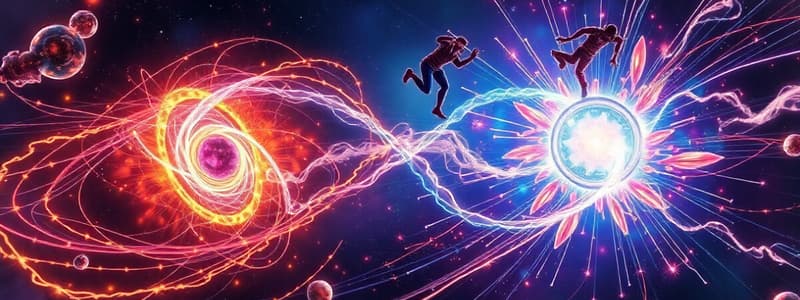Podcast
Questions and Answers
What describes the behavior of particles at atomic and subatomic levels?
What describes the behavior of particles at atomic and subatomic levels?
- Quantum Mechanics (correct)
- Thermodynamics
- Classical Mechanics
- Electromagnetism
Which particles are found in the nucleus of an atom?
Which particles are found in the nucleus of an atom?
- Electrons and Protons
- Protons and Positrons
- Neutrons and Electrons
- Protons and Neutrons (correct)
What is the process of splitting heavy nuclei to release energy called?
What is the process of splitting heavy nuclei to release energy called?
- Fission (correct)
- Fusion
- Electrolysis
- Decay
Which technology uses physical principles for imaging in medicine?
Which technology uses physical principles for imaging in medicine?
What type of nuclear reaction occurs in stars?
What type of nuclear reaction occurs in stars?
What is the primary role of the strong nuclear force?
What is the primary role of the strong nuclear force?
Which law of thermodynamics states that absolute zero cannot be reached?
Which law of thermodynamics states that absolute zero cannot be reached?
What principle explains why an object in motion remains in motion unless acted upon by a net force?
What principle explains why an object in motion remains in motion unless acted upon by a net force?
Which type of wave requires a medium for propagation?
Which type of wave requires a medium for propagation?
What does the equation for kinetic energy, KE = 1/2 mv², represent?
What does the equation for kinetic energy, KE = 1/2 mv², represent?
What phenomenon occurs when light bends as it passes through different media?
What phenomenon occurs when light bends as it passes through different media?
Which force is described as responsible for interactions between charged particles?
Which force is described as responsible for interactions between charged particles?
What does Einstein's General Relativity primarily address?
What does Einstein's General Relativity primarily address?
Flashcards are hidden until you start studying
Study Notes
Key Concepts in Physics
Fundamental Forces
-
Gravity
- Attractive force between masses.
- Described by Newton's Law of Universal Gravitation and Einstein's General Relativity.
-
Electromagnetism
- Force between charged particles.
- Governed by Maxwell's equations; includes electric and magnetic fields.
-
Weak Nuclear Force
- Responsible for radioactive decay and neutrino interactions.
- Operates at subatomic levels.
-
Strong Nuclear Force
- Binds protons and neutrons in atomic nuclei.
- Operates over very short distances.
Classical Mechanics
-
Newton's Laws of Motion
- An object at rest stays at rest; an object in motion stays in motion unless acted on by a net force.
- F = ma (Force equals mass times acceleration).
- For every action, there is an equal and opposite reaction.
-
Kinematics
- Study of motion without considering forces.
- Key equations relate displacement, velocity, acceleration, and time.
-
Energy
- Kinetic Energy: Energy of motion, KE = 1/2 mv².
- Potential Energy: Stored energy due to position, PE = mgh (for gravitational potential energy).
Thermodynamics
-
Laws of Thermodynamics
- Energy cannot be created or destroyed; it can only change forms (Conservation of Energy).
- The total entropy of an isolated system can only increase.
- Absolute zero cannot be reached.
-
Heat Transfer Mechanisms
- Conduction: Transfer of heat through direct contact.
- Convection: Transfer of heat through fluid movement.
- Radiation: Transfer of heat through electromagnetic waves.
Waves and Sound
-
Wave Properties
- Wavelength, frequency, amplitude, speed.
- Types: Mechanical (requires medium) and Electromagnetic (does not require medium).
-
Sound Waves
- Longitudinal waves created by vibrating objects.
- Properties include pitch (frequency), loudness (amplitude), and timbre (quality).
Light and Optics
-
Nature of Light
- Light behaves as both a wave and a particle (wave-particle duality).
- Speed of light in a vacuum is approximately 299,792 km/s.
-
Optical Phenomena
- Reflection, refraction, diffraction, interference.
- Lenses and mirrors manipulate light paths to form images.
Modern Physics
-
Relativity
- Special Relativity: Deals with observers moving at constant speeds; introduces time dilation and length contraction.
- General Relativity: Addresses gravity's effect on time and space.
-
Quantum Mechanics
- Describes behavior of particles at atomic and subatomic levels; emphasizes probabilistic nature.
- Key concepts include wave functions, uncertainty principle, and quantization of energy levels.
Atomic and Nuclear Physics
-
Atomic Structure
- Atoms consist of protons, neutrons (nucleus), and electrons (orbitals).
- Elements defined by atomic number (number of protons).
-
Nuclear Reactions
- Fission: Splitting of heavy nuclei releasing energy.
- Fusion: Combining light nuclei to form heavier nuclei, releasing energy (e.g., in stars).
Applications of Physics
-
Engineering
- Application of physical principles in design and construction of structures, machines, and systems.
-
Medicine
- Use of imaging technologies (e.g., X-rays, MRI) based on physical principles.
-
Environmental Science
- Understanding physical processes affecting climate, ecosystems, and energy resources.
Fundamental Forces
- Gravity: Attractive force between objects with mass.
- Described by Newton's Law of Universal Gravitation and Einstein's General Relativity.
- Electromagnetism: Force between charged particles.
- Governed by Maxwell's equations, including electric and magnetic fields.
- Weak Nuclear Force: Responsible for radioactive decay and neutrino interactions.
- Operates at the subatomic level.
- Strong Nuclear Force: Binds protons and neutrons together in atomic nuclei.
- Operates over extremely short distances.
Classical Mechanics
- Newton's Laws of Motion:
- An object at rest stays at rest and an object in motion stays in motion unless acted upon by an external force (Inertia).
- Force (F) is equal to mass (m) multiplied by acceleration (a): F = ma.
- For every action, there is an equal and opposite reaction.
- Kinematics: The study of motion without considering the forces involved.
- Key equations relate displacement, velocity, acceleration, and time.
- Energy:
- Kinetic Energy (KE): Energy of motion. KE = 1/2 mv² (where m is mass and v is velocity).
- Potential Energy (PE): Stored energy due to position. PE = mgh (for gravitational potential energy, where m is mass, g is acceleration due to gravity, and h is height).
Thermodynamics
- Laws of Thermodynamics:
- The first law states that energy cannot be created or destroyed, only transformed. This is the conservation of energy principle.
- The second law states that the total entropy of an isolated system can only increase over time.
- The third law states that absolute zero temperature (0 Kelvin) cannot be reached.
- Heat Transfer Mechanisms:
- Conduction: Heat transfer through direct contact between objects.
- Convection: Heat transfer through the movement of fluids (liquids or gases).
- Radiation: Heat transfer through electromagnetic waves.
Waves and Sound
- Wave Properties:
- Wavelength: The distance between two consecutive crests or troughs of a wave.
- Frequency: The number of wave cycles passing a point per second, measured in Hertz (Hz).
- Amplitude: The maximum displacement of a point on a wave from its rest position.
- Speed: The rate at which a wave travels through a medium.
- Types of Waves:
- Mechanical Waves: Require a medium to propagate, like sound waves.
- Electromagnetic Waves: Can travel through a vacuum, such as light waves.
- Sound waves: Longitudinal waves produced by vibrating objects.
- Pitch: Determined by a sound wave's frequency.
- Loudness: Determined by a sound wave's amplitude.
- Timbre: The quality of a sound, determined by the combination of different frequencies present.
Light and Optics
- Nature of Light:
- Light exhibits wave-particle duality: behaving both as a wave and as a particle (photons).
- The speed of light in a vacuum is approximately 299,792 km/s.
- Optical Phenomena:
- Reflection: The bouncing back of light off a surface.
- Refraction: The bending of light as it passes from one medium to another.
- Diffraction: The spreading of light waves as they pass through an opening or around an obstacle.
- Interference: The interaction of two or more waves, resulting in patterns of constructive and destructive interference.
- Lenses and Mirrors: Used to manipulate light paths to form images.
Modern Physics
- Relativity:
- Special Relativity: Deals with observers moving at constant speeds, introducing concepts like time dilation and length contraction.
- General Relativity: Explains gravity as a consequence of the curvature of spacetime.
- Quantum Mechanics: Describes the behavior of matter and energy at the atomic and subatomic levels, emphasizing the probabilistic nature of physical phenomena.
- Key concepts:
- Wave functions: Mathematical descriptions of the probability of finding a particle in a particular state.
- Uncertainty principle: It is impossible to simultaneously determine both the position and momentum of a particle with absolute accuracy.
- Quantization of energy levels: Energy in atoms and molecules can only exist in discrete, quantized levels.
- Key concepts:
Atomic and Nuclear Physics
- Atomic Structure:
- Atoms consist of a nucleus containing protons (positively charged) and neutrons (neutral), surrounded by electrons (negatively charged) occupying specific energy levels or orbitals.
- Elements are defined by their atomic number, which represents the number of protons in the nucleus.
- Nuclear Reactions:
- Fission: The splitting of a heavy nucleus into lighter nuclei, releasing a large amount of energy.
- Fusion: The combining of light nuclei to form heavier nuclei, releasing even greater energy. (This is the process powering stars).
Applications of Physics
- Engineering: The application of physical principles in the design, construction, and operation of structures, machines, and systems.
- Medicine: The use of physical principles and technologies, such as imaging techniques (X-rays, MRI, CT scans), in diagnosis, treatment, and research.
- Environmental Science: Understanding physical processes that affect the Earth's climate, ecosystems, and energy resources.
Studying That Suits You
Use AI to generate personalized quizzes and flashcards to suit your learning preferences.




